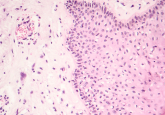Electron paramagnetic resonance determines in-cell distances

Researchers from the University of Konstanz (Germany), Bielefeld University (Germany) and ETH Zurich (Switzerland) have demonstrated that relaxation-induced dipolar modulation enhancement (RIDME) can be applied to determine the distances between gadolinium(III)-based spin labels in cells. Using the electron paramagnetic resonance technique allowed the researchers to work with molecules under native conditions to reveal essential structural information about macromolecules previously difficult to determine, including conformation, folding and unfolding mechanisms.
Current in-cell distance determination methods such as double electron-electron resonance (DEER) are much less sensitive, provide smaller modulation depths, have excitation bandwidth limitations and are technically more demanding than the new RIDME technique.
“We started out by analyzing the conformation of a protein inside the cell. With less sensitive techniques, we are forced to insert and tag a lot of protein to be able to observe it, which is not at all what happens in nature. Ideally, we want to be working with concentrations that are physiologically relevant,” explained authors Malte Drescher and Mykhailo Azarkh, from the University of Konstanz. “Since RIDME is much more sensitive than DEER, it allows us to do just that. We are now in a position to address issues that we would not otherwise be able to address.”
In the study, published in the Journal of Physical Chemistry Letters, in-cell RIDME performance was assessed using stiff molecular rulers of a known distance labelled with GD(III)-PyMTA and microjointed into Xenopus laevis (African clawed frog) oocytes. Results indicated that the new technique was more sensitive than conventional methods at determining the distance between two unpaired electrons, providing up to five times smaller modulation depths.
The next stage in this research will be to identify other suitable spin labels and develop RIDME for unknown in-cell spin label distances. The research will pay particular attention to molecules associated with neurodegenerative diseases including Alzheimer’s and Parkinson’s, with the overall goal to develop new approaches to spectroscopy that allow larger and more complex biological structures to be explored at the molecular level of the cell.
Sources: Azarkh M, Bieber A, Qi M et al. Gd(III)–Gd(III) relaxation-induced dipolar modulation enhancement for in-cell electron paramagnetic resonance distance determination. J. Phys. Chem. 10, 1477–1481 (2019); www.uni-konstanz.de/universitaet/aktuelles-und-medien/aktuelle-meldungen/aktuelles/aktuelles/New-technique-for-in-cell-distance-determination/





